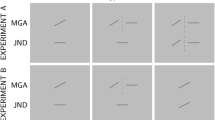Abstract
Typically, when a grasping response is made, the hand opens wider than the target object. We show that this “over-grasp” response is reduced when we reach to parts of our own face, relative to when we reach to other body parts or to neutral objects. This is not due to reaching to different parts of body space, as over-grasp responses are indifferent to whether or not other body parts or neutral objects are placed close to the face. It is also not due to differences in perceptual knowledge of the size of the target object. We conclude instead that the familiarity of face parts influences the grasping response directly. Subsequent experiments demonstrate that the movement representation determining any effect is not based on a torso-centred frame, and not abstracted from the specific hand used for grasping. We discuss the implications of the results for understanding and measuring motor representations for familiar actions.




Similar content being viewed by others
References
Bernstein N (1967) The co-ordination and regulation of movements. Pergamon, Oxford
Bootsma RJ, Marteniuk RG, MacKenzie CL, Zaal FT (1994) The speed-accuracy trade-off in manual prehension: effects of movement amplitude, object size and object width on kinematic characteristics. Exp Brain Res 98:535–541
Gentilucci M (2002) Object motor representation and reaching-grasping control. Neuropsychologia 40:1139–1153
Gentilucci M (2003) Object familiarity affects finger shaping during grasping of fruit stalks. Exp Brain Res 149:395–400
Jeannerod M (1981) Intersegmental coordination during reaching at natural visual objects. In: Long J, Baddeley A (eds) Attention and performance IX. Lawrence Erlbaum, Hillsdale, NJ
Jeannerod M (1984) The timing of natural prehension movements. J Motor Behav 16:235–254
Jeannerod M (1997) The cognitive neuroscience of action. Blackwell, Oxford
Jeannerod M, Decety J, Michel F (1994) Impairment of grasping movements following a bilateral posterior parietal lesion. Neuropsychologia 32:369–380
Kudoh N, Hattori M, Numata N, Maruyama K (1997) An analysis of spatiotemporal variability during prehension movements: effects of object size and distance. Exp Brain Res, 117:457–464
Marteniuk RG, Leavitt JL, MacKenzie CL, Athenes S (1990) Functional relationships between grasp and transport components in a prehension task. Hum Movement Sci 9:149–176
Milner AD, Goodale MA (1995) The visual brain in action. Oxford University Press, Oxford
Paulignan Y, Jeannerod M (1996) Prehension movements: the visuomotor channels hypothesis revisited. In: Wing AM, Haggard P, Flanagan JR, Hand and brain. Academic Press, London
Tipper SP, Howard LA, Houghton G (1998) Action-based mechanisms of attention. Philos Trans R Soc London B 353:1385–1393
Wing AM, Turton A, Fraser C (1986) Grasp size and accuracy of approach in reaching. J Motor Behav 18:245–260
Acknowledgements.
Separate MRC programme grants to Wing and Humphreys, and an MRC Co-operative grant to Humphreys and Wing. Thanks to Umberto Castiello and Randy Flanagan for their comments on this paper.
Author information
Authors and Affiliations
Corresponding author
Rights and permissions
About this article
Cite this article
Edwards, M.G., Wing, A.M., Stevens, J. et al. Knowing your nose better than your thumb: measures of over-grasp reveal that face-parts are special for grasping. Exp Brain Res 161, 72–80 (2005). https://doi.org/10.1007/s00221-004-2047-2
Received:
Accepted:
Published:
Issue Date:
DOI: https://doi.org/10.1007/s00221-004-2047-2



